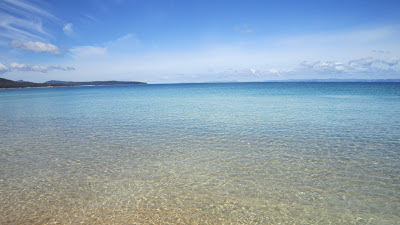Despite its small land area, Tasmania is home to 19 national parks. We had the privilege of visiting 4 very different ones on our 10 day tour. In no particular order:
Franklin-Gordon Wild Rivers National Park
Named after the Franklin and Gordon Rivers which run through the park, the vast Franklin-Gordon Wild Rivers National Park is Tasmania’s second largest by land area. Not the most accessible, our visit to the park consisted of two short hikes off of the Lyell Highway which straddles the park’s northern boundary. First stop, Nelson Falls:
Followed by Donaghys Hill. From atop the hill, you get a fantastic view of Frenchmans Cap – one of the most recognizable features of the national park.
Both Nelson Falls and Donaghys Hill were on the list of Tasmania’s 60 Great Short Walks which is compiled by the Tasmania Parks & Wildlife Service. Looking at the brochure after the trip, I was surprised to find that we actually did 10 of the 60 Great Short Walks. Not a bad effort for a 10 day trip.
Freycinet National Park
I had never heard of the name Freycinet National Park before coming to Tasmania, but one of its main natural features had been near the top of my list of things to do in Australia for quite some time. I’m referring to the beautiful and famous Wineglass Bay:
Along with the Bay of Fires just a few hours to the north, Wineglass Bay is consistently named one of the most beautiful beaches in the world by beach experts. I don’t know what qualifies you as a beach expert, but I suppose if you get published in a big magazine or two then you’re somewhat legit. Looking at the shape of the bay in the above photo, I just assumed that it was named Wineglass Bay solely because of its shape. But I was wrong. After the trip, my friend Jessica mentioned it was because of whaling. Further research found that she was indeed spot on. Extensive whaling had occurred in the area in the 1800’s. Whalers would drag their catches into the bay and do whatever it is that whalers do to whales. On a busy day, the waters of the bay were dyed red with whale blood. That combined with the shape, looked like a glass of red wine.
Disgusting.
Fortunately, there hasn’t been whaling here in a long, long time and the beach has returned to its uber-gorgeous state:
The water was frigid. Here’s me bracing as the cold waters came over my feet and splashed up on me:
Despite its beauty, Wineglass Bay is not the only thing that draws people in. The park sits on the Freycinet Peninsula which separates the Great Oyster Bay from the Tasman Sea and Pacific Ocean. A short track over the flat isthmus across the peninsula led us by some very different scenery: a lagoon.
We ended up at Hazards Beach on Great Oyster Bay. The water was so clear. Had I brought my bathing suit, I would have jumped in despite the frigid temperatures.
Finally, we drove around the other side of the park to Cape Tourville, site of a lighthouse, views of Wineglass Bay, and a great photo opportunity over the Tasman Sea:
Mole Creek Karst National Park
One of Tassie’s smaller national parks, Mole Creek Karst has an extensive collection of caves. We toured two of the more famous caves that are open to the public. King Solomons Cave is named as such for no apparent reason other than to bring in tourists, but it had some impressive stalactite and stalagmite action going on:
King Solomons Cave is a dry cave, while our second cave was a wet one. The Marakoopa Cave has a river running through it on the ground and a small sampling of glowworms on the ceiling. One of the main attractions of the extensive cave is the Great Cathedral, named so because of its acoustics. Additionally, the rock formation in the Great Cathedral looks a bit like a church organ.
Cradle Mountain-Lake Saint Clair National Park
One of the must-do things in Tasmania for most tourists is Cradle Mountain. We started with the roughly 2-hour Dove Lake Circuit when we arrived one evening. The views of Dove Lake with Cradle Mountain in the background were stunning:
But even better was our hike the next day. What started out on a very flat boardwalk track…
… but it very quickly changed scenery a time or two. There was lush plant life and rivers around Crater Falls:
I missed a separate picture of Michael in the last blog, so I thought I’d make up for it here. Up a bit further was Crater Lake, which isn't actually in a crater but that’s totally ok because it was pretty.
Up further we reached Marion’s Lookout. I don’t know who the hell Marion is, but she sure found a place with a nice view. Down below was Dove Lake (right) and Lake Lilla (left):
In the other direction was Cradle Mountain itself:
I just had to get a panoramic video too (because I’m a nerd… and because I have a really big memory stick on my camera…) I zoomed in on a little lake just sitting up on the mountain side. There were heaps of lakes at all different elevations around the park. Maybe I don’t get out much, but I had never seen anything like it before.
'
Tasmania’s national parks definitely did not disappoint. Now that we’ve been to four of them, there’s only one thing to say:
Four down. Fifteen to go. Tasmania 2013 anybody?
















No comments:
Post a Comment